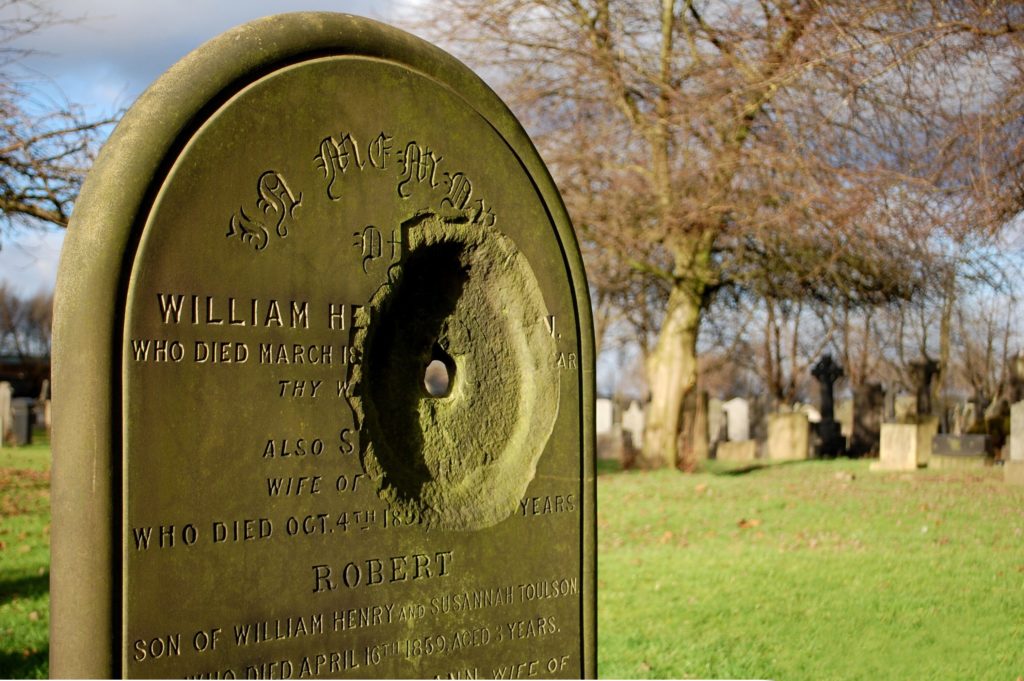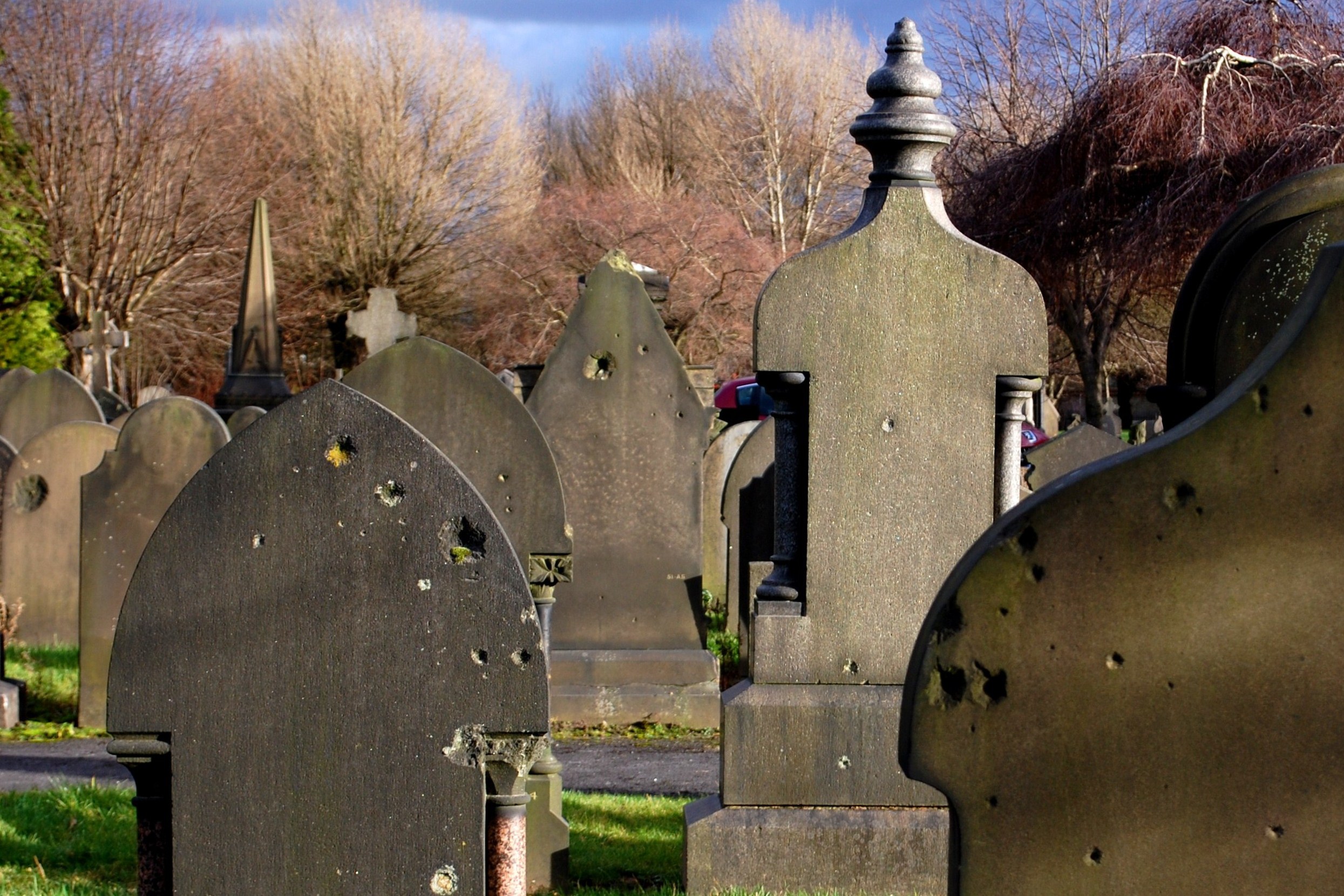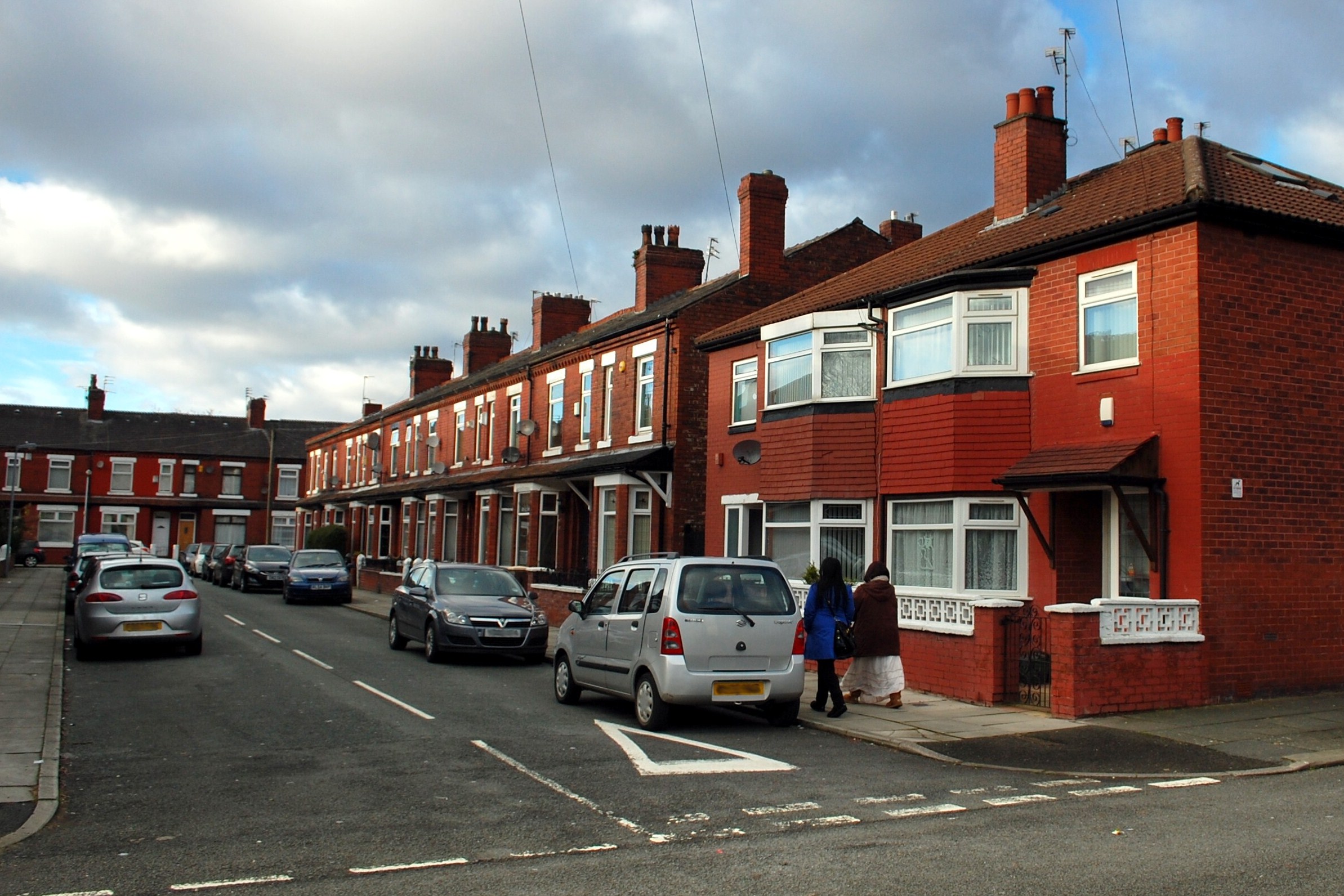The Christmas Blitz, Manchester, 1940
‹ Return to Air raids & bomb sites

Weaste Cemetery after an air raid on Salford and Trafford
Over the nights of Sunday 22 and Monday 23 December 1940 the Luftwaffe launched the war’s largest air raids on Manchester and the surrounding towns. Although sometimes referred to as the Manchester Blitz or the Salford Blitz etc, numerous towns including Oldham and Stretford were badly hit, with bombs also falling on Stockport and Altrincham.
The photo above shows a gravestone at Weaste Cemetary in Salford. A number of bombs fell here and many headstones still bear the scars from the air raid. As can be seen in the area beyond the headstone, a number of graves were lost in the attack.
Salford was hit because bombers were aiming for the nearby docks and industrial areas at Trafford.
Over the two nights, 441 bombers dropped some 467 tons of high explosive and 1925 incendiary bombs on Manchester and the surrounding towns.
684 people were killed over the two nights.

These headstones are about here on this Google map
maps.google.co.uk/maps?q=weaste+cemetery&hl=en&ll…
Period photo showing a bomb crater.



This is 21 Milton Avenue, Salford. Note how the houses are terraced apart from those nearest the camera. They were built after a bomb fell here on December 22, killing Mr Joseph Gatley Cooper (aged 52), and his daughters Catherine (17) and Gladys (23). Mrs Catherine Cooper was not listed as dead so it is presumed she was injured but survived. Or she may have been at work. The dead are buried in a mass grave at Agecroft Cemetary.
Most of Salford’s bombed streets have been rebuilt and many streets where bombs fell no longer exist. There is no particular relevance about this place, I just wanted to find and photograph a location where civilians were killed in the attack which still looks similiar today to how it did 72 years ago.

45 comments on “The Christmas Blitz, Manchester, 1940”
Leave a Reply Cancel reply
Image Information
-
Full Size: 3008×2000px
Aperture: f/5
Focal Length: 34mm
ISO: 200
Shutter: 1/400 sec
Camera: NIKON D40



Interesting story and pictures as usual, Ian!
You really are good at these Ian. You bring an, at first sight, simple gravestone’s chip to life with the story behind it.
Bob on mate!
Great work Ian. The bomb damage to the gravestone is interesting, did the projectile come from the back you think?
Thats a great trace of war Ian ….how more can something exemplify how dreadful it must have been .
[http://www.flickr.com/photos/genf] [http://www.flickr.com/photos/longsidepies] [http://www.flickr.com/photos/pasujoba44] [http://www.flickr.com/photos/peacelovescoobie] Thanks very much guys. Keith I don’t know, I was looking at the stones tryng to figure out the direction the shrapnel came from… the area beyond suggests it came from behind, but I really don’t know. There is no universal pattern on the gravestones, the shrapnel damage on some looks like they have been riddled with bullets while others have been smashed in two or have similar holes punched in them. I will upload some more at a later date. By the way, took a leaf from your book and did this on the anniversary of the incident!
As a man with an interest in local history, I have learned something here today..
Thanks for that Ian, wonderful insight given with the usual skill and fantastic knowledge..
Excellent research and great photos.. Well done.
amateur bolistic scientist here 🙂 … the shrapnel that damaged this stone clearly came from behind a piece smaller than the small hole in the centre hit the back of the grave stone punching the face of the gravestone off ….it probaly passed all the way through but there is a small chance that it fell back upon the side it hit that would depend on the speed it was travelling and the power excerted in punching the hole in the gravestone (it almost certainly passed through though).
I watch far too many crime programmes on TV ..that will be the wifes fault 🙂
grand shot that top one – really has impact [poor pun but totally unintentional]. great that you have carried this out on the anniversary .. i wonder you were noticed by those running in a parallel dimension? probably noticed, and appreciated.
[http://www.flickr.com/photos/pasujoba44] that is an excellent diagnostication!
Interesting story and set of pics Ian. Pasujoba has certainly nailed the analysis of the damaged stone; reminds me of when a drill passes through the back of a piece of wood too fast.
Since the London Bomb site appeared on the net I have been researching where family members lived. My father was able to confirm where the bombs landed close to where he lived as a youngster and he also reminded me of the time he picked up a whole line of incendaries stuck in the road and a copper rain after him!! I have also been able to pinpoint the exact date when he witnessed a V2 explode from other accountsof the incident. Terribly sad but all very interesting from a local and family history perspective.
Cracking photography Ian and a sobering thought that even graveyards don’t escape such events! Great to see your composite shot of that parachute mine again. As stated above you really are good or IMHO the ‘master’ at this detective work and subsequent presentation. Always extremely interesting and informative too and you obviously love the quest you set yourself in doing it! I look forward to more 🙂
what a powerful reminder of history … great composition to this image Ian … thank you for all your wonderful comments on the DDP … I really hope you have a wonderful Christmas 🙂
Cracking historical presentation Ian. And thanks to DCI [http://www.flickr.com/photos/pasujoba44] for the scene of crime explanation.
I worked with a lad whose parents lived in Weast, Salford at the time.. he told me a macabre tale of how "they" gathered all the disinterred skeletons from the graves hit by bombs and placed them and all manner of "odd bits and bats" in a mass grave… For the sake of returning families after the war.. they re-erected some "knocked" over gravestones, but the graves were empty….
My Dad was trying to get home on a 24 hour leave from the Army on the day of the raids, but could not get further than Stockpot on the train as all the lines were closed through Manchester.. He did not see my Mum for another 12 months……
Cracking research as always Ian and very well presented.
great info ian and of course great photos to follow brilliant work ian
you have a great christmas and a great new year
and thanks for the great photos from you
hope we have many more in 2013
take care
[http://www.flickr.com/photos/richardtierney]
It must have been dreadful !
Merry Christmas Everyone!
[http://www.flickr.com/photos/25305713@N04] Thanks Wilf. These are places you will be familiar with?
[http://www.flickr.com/photos/nondesigner] Thanks Malcolm. Best wishes.
[http://www.flickr.com/photos/pasujoba44] [http://www.flickr.com/photos/peacelovescoobie] Well done DCI Pasujoba. Cleared that up nicely, guv.
[http://www.flickr.com/photos/angwickham] Those running in a parallel dimension… There’s an interesting idea…
[http://www.flickr.com/photos/reflectionsreturn] It’s really good to research this stuff, there’s loads of resources out there. I looked at that map and wished I was in London… If I was in London, that’s all you’d ever see on my stream!
[http://www.flickr.com/photos/29288836@N00] Thanks Rob, you are too kind. And there is more to come! I thought similar to you too re; the dead being bombed. So much for resting in peace! I met one couple at the cemy who knew someone who’s family graves were blown up and as a result he insisted on being cremated when the time came to plan his own funeral arrangements.
[http://www.flickr.com/photos/richardtierney] Richard thank you for adding that. I did wonder about the ghastly task that must have befell those clearing up afterwards. Interesting to hear about your Dad too. He will have had to find shelter at some point too, as the area around Stockport was also bombed. Fairey aviation had a factory there.
[http://www.flickr.com/photos/paloetic] Thanks Palo, have a good Christmas. You are ahead of us so I suppose Santa is doing his rounds on the other side of the planet at this moment…
[http://www.flickr.com/photos/amybigkiss] Cheers Amy. I am impressed too!
[http://www.flickr.com/photos/mick_cooke_wildlife] You too Mick. I am now becoming able to identify a number of our feathered friends from looking at your excellent photos.
That is an amazing photo, very interesting history.
[http://www.flickr.com/photos/maycontaintracesofnuts] Very much so Ian..
What an amazing set of photos – thank you for sharing the stories too.
I hope you have a wonderfully Merry Christmas – thank you for being a great Flickr friend. :~}
[http://www.flickr.com/photos/richardtierney] good grief. amazing what people endured!
[http://www.flickr.com/photos/maycontaintracesofnuts] i blame too many Pratchett reads for my non-scientific attempts to understand scientific concepts. he makes things way fun.
Merry Christmas Ian,have a fab day mate from Fiona and I,hope you come back up our way again some day
What a history! Wonderful pictures to go with it too!
Wow, that’s so sad, even the dead are often victims of a war.
My Great-Grandparents were buried in Weaste Cemetery. I knew nothing about the war damage to the graves and head-stones.There are still the written records of names of the internments available.
Interesting set of photos, and good reportage, Ian.
The damage of the gravestone looks a little strange. If I didn’t know that it had been a shrapnel, I would think that the gravestone had been hit from behind by a dumdum bullet! The entrance hole is small and regularly round with such severe devastation on exit.
keeping history alive

in: Traces of War
Nice shot, Ian. Interesting to see some tangible mark from the events. Reminds me of the churchyard of St Mary Redcliffe in Bristol, where there still remains a length of tram track embedded javelin like in the grass – it had been launched into the air when a bomb detonated nearby.
Great story as usual bud and a nice shot to go with it, got me wondering if any of the raiders came to grief over the moors?
I know we have some German graves here from Operation Gisela, I’ll tell you about it sometime!
Incredible photo.. History brought back to life.
nice to see these in the group 🙂
Thankyou for sharing

with the War Stories Group
Flippin ‘eck – that’s some exit wound on the gravestone!
Interesting stuff.
I like how your parachute mine composite came out.
Very moving use of a small detail to represent the wider event, such poignancy, great photography
great work
[http://www.flickr.com/photos/bazylek]
Hollow point or expanding bullets have that effect on soft tissue with the gradual expansion and softness of the tissue.
Not necesarilly on stone ie impact may fragment the front with projectile going on through a clean hole.
Or solid ball bearing coming from rear taking out front.
No expansion necess.
this is one of my fave shots of yours ! and this link came through on the feed i have
set up from your blog
So it does work? I shall have to set something up to make it easier. Thanks Paul.
Hi Ian – just seen your photos of Weaste. I emailed you in the past on Flickr. This is just a quick message. In the 1970’s my nan had a letter that said that the gravestones in Weaste were going to be moved (to tidy it up – I think was the reason they gave). I remember it upset her a lot at the time as her parents and aunts etc are there and so when she went to take flowers it would no longer be at the grave but just to a headstone. I’m only saying this as the graves with shrapnel may also have been moved so you’d never really know from what direction they were hit. Having said that I’m not sure how much ‘tidying’ actually happened as I was only small when I used to go with her and don’t remember where the graves were.
Helen
Interesting note Helen, thanks for adding that. I didn’t know about the tidy up and that some of the damaged headstones were moved. Makes sense now you mention it.
Thanks for your visit by the way – I remember you well from flickr! How are you? Are you still on flickr? Send me a link to your stream if you are, not been on there in ages.
Hope all’s well with you.
Ian
Ian
Bang on the knocker keep it up.
Lived through the horrific Christmas at Bradford next block down from St BRIGID’S.
Collected a bucket of shrapnel next morning which we stored in the school yard.
I was born 10th December 1939 Pendleton Salford. We had a communal Air raid shelter in Percy St and I still remember one of our neighbours from marple st lying across us kids when the germans were coming over. After the war we played on top of the shelter (it had a flat roof)
This is an old thread… but I thought I’d add my pennies worth.
1. The shot had to have come from behind the gravestone in Pic1 because there’s no sign of ‘Cavitation’ (pitting and damage caused by high velocity shrapnel carried along with the initial impact shock wave) – thus the larger exit ‘wound’ at the front of the gravestone.
2. I’ve lived ‘down-south’ for some time now – and most Southerners have no idea that the North did anything during the war, I kid you not. Many believe that we were living the life of Reilly while the war raged. It’s a constant source of irritation and anger for me.
3. Most Southerners have no idea where the real wealth of Great Britain came from – the cheap labour of the North.
After the First and Second world wars, many ‘established families’ (that is: land rich, cash poor) were in desperate need of money and ‘New Blood’ – to keep the ‘family name’ going – their kids, having been automatically given the roles of Officers, despite the fact that many had fewer than the usual number of marbles.
Northern Mill / Mine owners looking to ‘upgrade’ there own status saw an opportunity and married into these families – thus money moved south.
Northerner – through innovation and pure, bloody physical labour – have always been the backbone of this country, yet we’ve always been treated like second class citizens.
Maybe it’s time we asked for our due.
Hi Fred, thank you for your comments. One reason I started to document the Blitz as it affected the people of the North west of England was because I was annoyed that most studies about the Blitz are about London and the South east only. I have plenty of books on the subject, but cities that were severely damaged by the Luftwaffe, Liverpool (and Hull) especially, aren’t much documented and if Manchester gets a mention it is rarely much more than a footnote.
There is a cast iron bridge in Liverpool with similar holes as the gravestone but that was done by a Heinkel bomber that machine gunned the area. I no they use to fill some bombs with ball bearings but toward the end of the war it was stopped as bearings were hard to produce. The damage does look to neat for shrapnel id say the bomb was full of ball bearings.